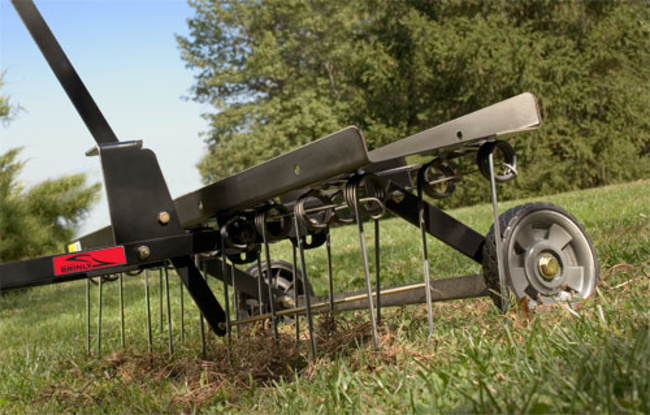Dethatching Your Lawn
What is Thatch?
Thatch is the layer of living and dead stems, roots, stolons, and rhizomes between the green blades of grass and the soil surface. A thin layer of thatch (less than 1/2 inch thick) can be beneficial to the lawn because it helps to limit weed germination, reduce water evaporation, and protect from frost damage. However, thick thatch layers can prevent water, air, and nutrients from penetrating the soil, causing reduced root growth and increased potential for drought stress. Thatch also favors fungal growth and can harbor insect pests. Some turfgrass species, such as tall fescue and perennial ryegrass, do not produce much thatch. Other turfgrass species, such as bermudagrass, bentgrass, and Kentucky bluegrass, have creeping growth habits and rapidly build thick thatch layers.
When to Dethatch
Walk your lawn and look for the following signs that indicate excessive thatch and the need for lawn dethatching.
- -grass is green on top but brown underneath
- -looks dead and scalped when you mow
- -lawn is thinning and off-color OR is thick, rich and green but you can't see bare ground between the plants, but only matted, fibrous material
- -grass feels "spongy" to walk on
How to Recognize What's Too Much Thatch
You'll have to look at a cross section of the turf to see how much thatch there is on your lawn. The best way to do this is with a knife, a trowel or a shovel. Take a sample of the lawn by removing a plug of turf, just like cutting a piece of pie. Make sure your sample is large enough so you can see a complete cross section that includes the grass, the thatch, the roots and the soil. Measure the layer of thatch between the top growth and the root zone to see if it's more than 1/2 inch deep. Anything over the 1/2 inch depth needs to be corrected. It's time for a lawn dethatching.
What Time of Year Should You Dethatch?
Cool season lawn grasses are best dethatched in the early fall or early spring when new grass shoots won't get damaged. Don't dethatch your lawn between times of dormancy and active growth when nutrient stores and energy in the roots are low.
Getting the Lawn Ready Before You Begin
It's important to prepare the lawn before dethatching by mowing it at the lowest height on your mower. Then, water lightly so the soil is moist, but not saturated. If it's too wet the turf will be torn by the equipment.
The Lawn Dethatcher
A lawn dethatcher is essentially, a large mechanical rake designed to remove thatch. It's much faster, more efficient, and far more effective than trying to do it by hand.
Hand raking a larger lawn is very physically demanding and time consuming. Most hand rakes just aren't designed to dislodge those thick matted layers of thatch.
How to Dethatch
By running the dethatcher steadily and slowly across the lawn, the rotating blades penetrate the grass and pull up the thatch underneath. The height of the blades as well as their spacing can both be adjusted. A good depth is 1/4 inch above a hard surface.
You don't want to pulverize the soil surface. Run the dethatcher steadily over the lawn, making successive passes just like mowing the lawn. Follow these with similar perpendicular passes until the thatch is removed.
Raking Up
Use your garden rake to remove the thatch by raking into piles to be bagged and removed. Don't be surprised by the large amount of debris you'll collect. Considering you have a pesticide-free lawn, the thatch you've collected can be used for mulch or put in the composter. At this point your lawn will look pretty rough with many bare patches and rather straggly grass. This is a 'tough love' remedy so you'll just have to put up with its poor appearance for about four weeks while it recovers.
Follow Up Care
At this point it's a good practice to apply a good quality, slow-release organic fertilizer to help stimulate re-growth. Thoroughly watering the lawn is important to keep it from drying out while the protective layer is being re-established. Immediately following a lawn dethatching is a great time to add some grass seed to help in the recovery process.
Tips for Lawn Dethaching
Regular dethatching produces buds that grow near the base of the stems which prevents the grass plants from being dead underneath and green on the top only.
If thatch measures more than 1/2 inch deep, you should dethatch your lawn.
Repeat lawn dethatching once every two to three years.






